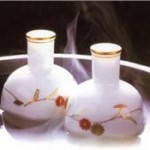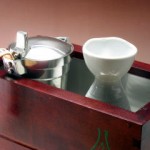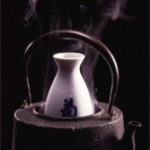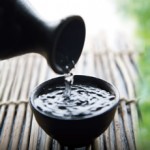 Today, we enjoy most of our premium sake slightly chilled. I hope that most readers are with me in the acceptance of that general concept. While certainly there are exceptions to this – many of them delicious – it is true that most ginjo sake especially sees its finest aspects highlighted when very slightly chilled down. The reasons for this are hardly rocket science: the delicate flavors and oftentimes fruity aromas that the brewers worked so hard to create are most prominent at these cooler temperatures.
Today, we enjoy most of our premium sake slightly chilled. I hope that most readers are with me in the acceptance of that general concept. While certainly there are exceptions to this – many of them delicious – it is true that most ginjo sake especially sees its finest aspects highlighted when very slightly chilled down. The reasons for this are hardly rocket science: the delicate flavors and oftentimes fruity aromas that the brewers worked so hard to create are most prominent at these cooler temperatures.
But has it always been like this? Oh, heavens, no. Remember that ginjo sake, and sake made with very highly milled rice, has only been on the market about forty years or so. And the flavor profiles of sake before that were significantly different than they are today.
Does this mean that all sake sucked before the advent of ginjo? No; of course not. But it  was different: fuller, richer, at some periods of time a lot sweeter, and often with a significantly higher acidity. And it was, in fact, overall much more suited to warming than modern ginjo types. Actually, that is the real reason we see hot sake all around us in spite of the fact that so many are rightly intoning that premium sake should be served chilled: that is the temperature range at which the flavors and aromas of good ginjo are most easily enjoyed.
was different: fuller, richer, at some periods of time a lot sweeter, and often with a significantly higher acidity. And it was, in fact, overall much more suited to warming than modern ginjo types. Actually, that is the real reason we see hot sake all around us in spite of the fact that so many are rightly intoning that premium sake should be served chilled: that is the temperature range at which the flavors and aromas of good ginjo are most easily enjoyed.
An important point is that while it is true that heating can and does cover blemishes in a cheap sake, that is not why they started doing it. No brewer or distributor ever said, “Wow, this stuff is pretty bad. Let’s tell everyone to heat it to get beyond that!” Again, for emphasis: Sake is not heated to cover faults!
The truth is that sake has been enjoyed warm since long ago, and many producers keep that tradition alive, in a sense. A longer treatise on the roots, rhyme and reason of warming sake stretching back about 1000 years can be found here , for those that are interested.
So in modern times, while we see inexpensive sake being heated all around us, we sit quietly enjoying our premium stuff gently chilled. And I reiterate that there are indeed exceptions: there are premium sake even in the ginjo range out there that have earthier, unique flavor profiles that benefit from a tad of warming.
 In fact, perhaps the one thing that has changed in terms of my own preferences for sake is that over the years, I have become increasingly fond of properly warmed, premium sake. Nothing beats it. Nuff said. Notice I did not say hot. Warming sake to lukewarm or slightly warmer temperature will benefit sake with the right flavor profiles. But overheating is another animal altogether. Obviously, nothing can be tasted or sensed when sake is overheated, so avoid extremes of heat.
In fact, perhaps the one thing that has changed in terms of my own preferences for sake is that over the years, I have become increasingly fond of properly warmed, premium sake. Nothing beats it. Nuff said. Notice I did not say hot. Warming sake to lukewarm or slightly warmer temperature will benefit sake with the right flavor profiles. But overheating is another animal altogether. Obviously, nothing can be tasted or sensed when sake is overheated, so avoid extremes of heat.
If one were to wander in to a local pub sixty or more years ago, you would be given a choice of probably one sake: the local one, in but one or two manifestations. You might sit around a square charcoal pit with your companions that evening, and in a remote corner of the pub would be a man whose sole responsibility would be warming the sake for all the customers. Known as the o-kan-ban, he would take orders for sake, sometimes requested at warm, lukewarm, or hot temperatures, and sometimes for just “sake.”
He knew his regulars, and how they liked their sake. He would likely have a kettle of hot water into which he would immerse numerous sake flagons called tokkuri, watching and timing them all carefully until each was ready in turn to go to their rightful owner at precisely the temperature requested or preferred.
But we don’t see these journeymen any more.
Although it is only peripherally related to the topic at hand, during World War II brewers found their rice understandably rationed, and were forced to cut their product with grain alcohol to further decrease the potential to squander rice. It was an unavoidable situation resulting from the chaos in the world at that time.
Mr. Hideharu Ota, president of the brewery making Daishichi sake in Fukushima, once explained to me, “During the war, naturally, sake consumption and production dropped tremendously. After the war, slowly but surely, sake production returned to its pre-war level. But there was a 20-year gap in sake culture, in the culture of sake enjoyment, and even though sake production and consumption were restored, sake culture never returned to its pre-war levels. That gap was too big to fill.”
True, this permanent change in sake culture was aided and abetted by massive changes in society and lifestyle. But whatever the rationale, much was lost culturally. And not the least of these was the almost total disappearance of the o-kan-ban. While I do know of one place in Tokyo that has one (or at least had one, as I have not been there in a couple of years), and I am sure there are others, they are for the most part gone.
Recently I read an interview of an elderly gent that had been an o-kan-ban so many years ago. He described the complexity of his work, and mentioned too a few tricks of the trade.
“If I see I guy come in from the cold,” he began, “he might sit down, wipe his nose, and  order an atsukan (hot sake). Well, I know his body is chilled, and whatever I send him will seem hotter than it is. So I would serve it a little less hot than usual for him. But I am watching everyone all night. And let’s say I see someone glance at his watch and order what he thinks will be one last flagon of warmed sake. I would send it over that table just a tad less warm then he would like it. This would almost always entice him to order one last one to warm him for the road home.”
order an atsukan (hot sake). Well, I know his body is chilled, and whatever I send him will seem hotter than it is. So I would serve it a little less hot than usual for him. But I am watching everyone all night. And let’s say I see someone glance at his watch and order what he thinks will be one last flagon of warmed sake. I would send it over that table just a tad less warm then he would like it. This would almost always entice him to order one last one to warm him for the road home.”
Something tells me that the pub at which this gentleman worked was a fun and profitable place.




